
Intro
In our October newsletter, we discussed how exercising can be beneficial at a mental and physical level for breast cancer patients and survivors. In this article, we wanted to touch on different types of exercises that can be advantageous, as well as exercising safely. If undergoing treatment, or if there are certain risk factors, a physician should be consulted before starting any exercise or exercise programs. Doctors are not certain exactly why exercise helps to reduce individuals’ risk of getting breast cancer as well as its’ recurrence, but they suspect it has to do with regulation of insulin and estrogen, which happens with regular exercise. Being at a healthier weight helps to regulate hormones and the immune system.
Exercise Guidelines
The American Cancer Society recommends 150 minutes of moderate intensity exercise or 75 minutes of intense vigorous activity, spread throughout the week. Some examples of moderate intensity activities include brisk walking, dancing, leisurely biking, yoga, softball, and general yard and garden maintenance. Some examples of intense vigorous activity includes jogging, running, and swimming. These are just suggestions, as there is a multitude of different activities that could be done in order to reach the recommended amount of weekly exercise. For individuals who that have been inactive for a while, it is a good idea to build up to the weekly recommended amount of exercise slowly and safely.
Types of Exercise
There are three main categories of exercise; aerobic, flexibility, and strength training, that are recommended to help reduce the risk of breast cancer and its’ reoccurrence after having been diagnosed.
Aerobic exercise can be an easy, fun, and effective way to exercise on your own with little to no equipment or guidance needed. Aerobic exercise has many benefits including boosting your mood, helping you to get better sleep, and reducing the risk of stress. Some of the types of aerobic exercise are outlined in the exercise guideline paragraph above. It is a good idea to find what form of exercise you enjoy the most, so you have a better chance of long term adherence. Aerobic exercise can also be done at a gym, on cardio equipment or in certain types of group fitness classes, which can be done with the guidance of personal trainers.
Flexibility exercise, which can be referred to as range of motion exercise or stretching, including yoga and Tai Chi, can be done at home without supervision, but should be done with caution. At first, it may be better to do flexibility exercises under the supervision of a personal trainer to establish what is safe and effective for you as an individual, and what is truly painful and should be discontinued. Flexibility exercise can improve all aspects of an individual’s life, making activities of daily movement easier and more comfortable.
Strength training adds weight or resistance to a movement, which makes you stronger overall, strengthens bones, improves posture, and can address muscle imbalances or weaknesses. Strength training can be done at home with body weight, resistance bands or free weights, but may be more effective in a gym, where there are a variety of options and variations available. If unsure of what you are doing at first, hiring a personal trainer is a great way to be introduced to strength training. This approach facilitates having a professional to analyze the movements that you do in order to ensure that they are safe, effective and will reduce the risk of injury.
Exercising Safely
With any type of exercise and population, it is imperative that safety is prioritized. This is especially true for breast cancer survivors and individuals being treated for breast cancer. It may be necessary to avoid some exercises that put excess stress on the upper body or in some cases, they can be modified and gradually progressed over time. It is of great importance to always warm up your entire body before beginning any form of exercise and stop if anything does not feel right. Rest as needed and be sure to cool down afterwards. If you are a male over the age of 45 or female over 55, it is important to acquire a Physician’s release before commencing an exercise program. The next step is to work with a certified personal trainer to assist with ensuring your safety. Please be sure that your doctor and personal trainer are on the same page as far as knowing what procedures you have had and what exercise program you intend to start, as well as your desired goals.
Finding a certified trainer
There are some personal trainers that are certified to work specifically with cancer patients through the American College of Sports Medicine. It is important to trust and feel comfortable with your personal trainer, so do not be afraid to ask for certifications, education, and experience.
Check out this link: https://www.breastcancer.org/research-news/updated-exercise-guidelines-for-cancer, for specific exercise recommendations for certain side effects that you may be experiencing, such as anxiety, fatigue, or lymphedema.
This foundation, Cancer Wellness for Life, https://www.cancerwellnessforlife.com/ is a great resource for individual’s looking for Cancer Exercise Specialists. This organization is highly experienced in designing fitness and nutrition programs for individuals with cancer.
Remember, for almost all populations, any type of movement is going to be beneficial compared to being sedentary.
Here at Say Fitness, we are available to help you achieve your goals, feel great, and look your best!
References:
https://www.cancer.org/latest-news/get-moving-to-help-reduce-your-risk-of-breast-cancer.html#:~:text=It’s%20thought%20that%20physical%20activity,keep%20the%20immune%20system%20healthier.
https://www.cancer.gov/news-events/cancer-currents-blog/2020/breast-cancer-survival-exercise
https://www.breastcancer.org/managing-life/exercise/types
https://www.breastcancer.org/managing-life/exercise/exercise-safely

